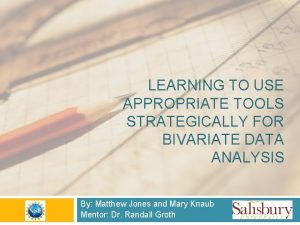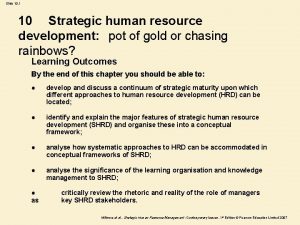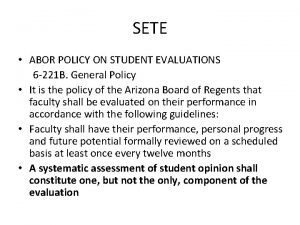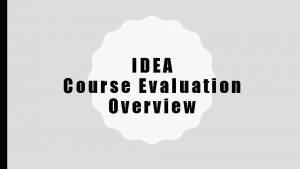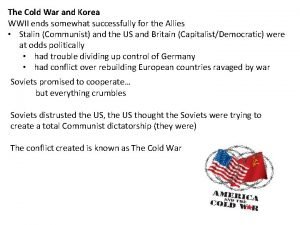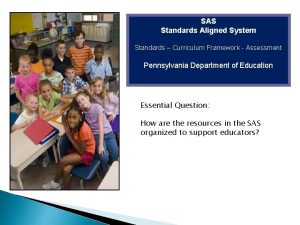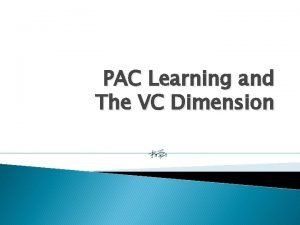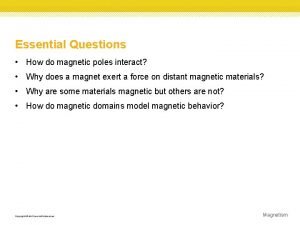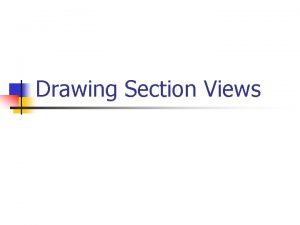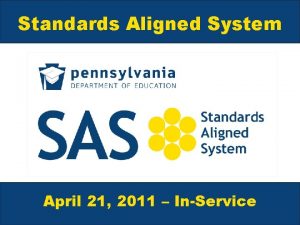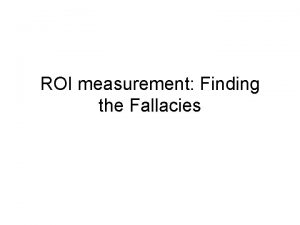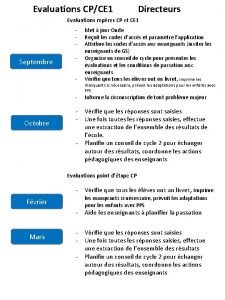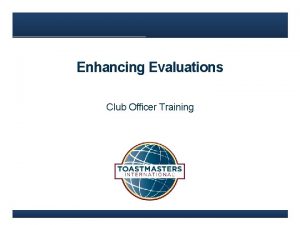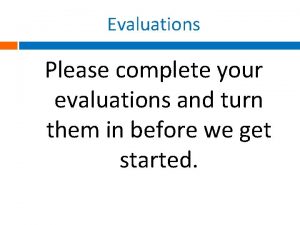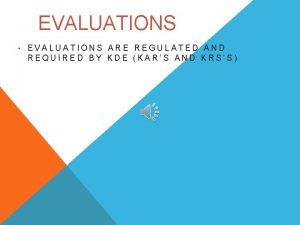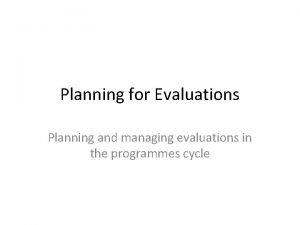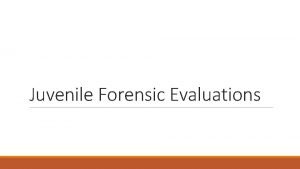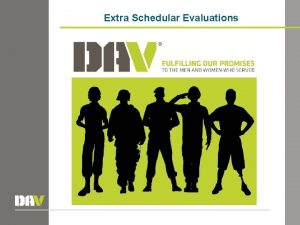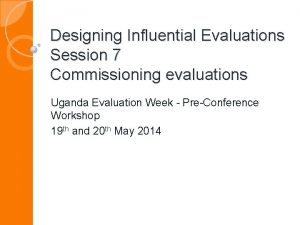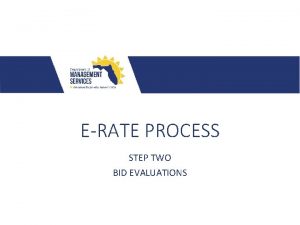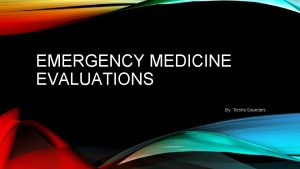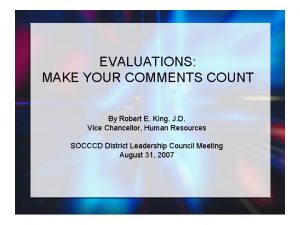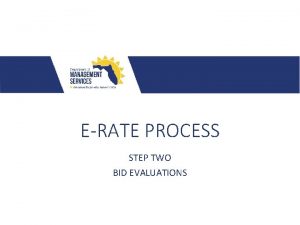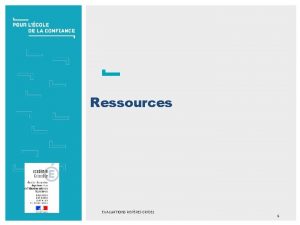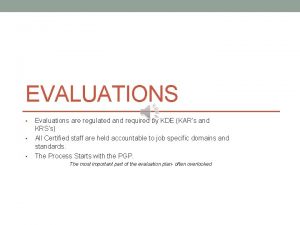HR ROI Strategically Aligned Measurement ROI Evaluations Whats




















- Slides: 20

HR- ROI Strategically Aligned Measurement: ROI Evaluations - What’s Missing? January 17, 2003 Jeanne Carsten & Luke Monck Copyright: JPMorgan Chase 1

New Paradigm for Human Resource Professionals …Old Paradigm g g g Staff function Tactical Focus on administrative efficiency Reactive Measures for compliance/ monitoring …New Paradigm g g g Part of the executive team Strategic partner* Focus on alignment of HR to business strategy Proactive Measures for strategic decision-making * Ulrich, 1997 2

Roles and Responsibilities …Management Determine strategic vision g Strategic vision informs the goals of the organization g Communicate the vision/goals to organization g Manage the business systems through which these goals are accomplished g …Human Resources Identify the relationship between HR systems and the strategic goals g Determine which HR systems are appropriate levers for attaining organizational goals g Develop initiatives for effecting these levers g Assess the impact of these initiatives g 3

Importance of Metrics and Measurement Build a fact-based view of human capital levers within the business system g Provide actionable information g Demonstrate value of human capital investments g Prioritize human resource initiatives to maximize impact and allocate limited resources g 4

Im pa Pe ct o rfo f M rm ea an su ce re Tr me aje nt cto on ry Using Metrics to Drive HR & Business Priorities Evolution • Develop system view • Diagnose alignment / gaps • Assess movement Evaluation • Articulate links between HR programs and business needs • Conduct programmatic assessments Education • Educate HR and business on role and uses of measurement • Build capability and tools (skills, metrics, databases) 5

HR Measurement: Moving Up the Performance Trajectory …Programmatic Focus: improving the effectiveness and delivery of HR function and justifying costs g Identifies HR costs and benefits associated with improving the process g Usually expressed in dollars g Example: Reducing turnover reduces costs associated with recruiting, staffing, training and development, etc. …Strategic Focus: demonstrating impact of HR on the strategic goals of the organization g Establishes empirical relationships between HR process and organizational goal of interest g Expressed in any metric aligned to the goals of the organization g Example: Reducing turnover in service delivery staff increases capacity and quality, and thus customer 6 loyalty/ share of wallet

Implementing Programmatic Measurement Essentially creating an exhaustive list of costs and benefits associated with the HR process in question. Required KSAs: Analytic skills Once the costs have been fully explicated the HR practitioner can obtain a cost per hire (actually turnover) and illustrate the revenue benefit associated with reduction of amount of turnover Manager’s time to terminate/hire HR time to terminate/hire Recruiting/ advertising costs Selection tools/ onboarding process + Entry training expense Total Cost of Turnover 7

Implementing Strategic Measurement Required KSAs: g Research methods g Organizational development/ systems view g Statistical analysis g Organization of databases High Turnover Low Customer Satisfaction - X ppt Turnover + Y ppt Customer Sat. 8

Where to Start: Establishing a Human Resource Measurement Strategy 1. Begin with the strategic objectives 2. Identify business outcome metrics to measure those objectives 3. Hypothesize relationship between HR processes and business outcomes 4. Create HR strategy based on hypothesized relationships 5. Test hypotheses through organizational research 6. Determine impact of change in HR lever on key outcomes 7. Develop initiatives to impact lever (measurement is an initiative) 8. Build measurement strategy 9. Integrate metrics into management scorecard 9

Culture Levers for Change Formal Levers • • • Vision/Values/Mission Strategic Direction Goals Work Process Technology Structure and Roles Information & Measurement Decision Making Processes Recruiting & Training Performance Management Recognition Compensation • Leadership Practices • Creating Alignment • Communicating • Gaining Commitment • Shaping and Reinforcing Behavior • Aligning Resources • Building Durability Measurement Tools: Behavior / output metrics Behaviors What we need people to do Organization Scorecards Results What we need to accomplish Pinpoint behaviors of interest *Culture is a pattern of behaviors that is reinforced and pursued by people and systems over time 10 CLG 2001

Case in a Commercial Bank g Commercial banking segment of a large multinational financial organization g Undergoing organizational change designed to transform the structure and processes and realize latent market sales revenue g Assess the impact of people management on the achievement of latent sales revenue g Objective is to align management of human resources to business goal g Create a strategic HR dashboard 11

Key Levers Capacity Management Sales roles filled with qualified people Competency Management Workforce ability/ performance level Environment Direction and motivation Turnover/ retention g Recruitment/ selection g Training & development g Performance management g Leadership g Culture g 12

Programmatic Measurement of Turnover Measurement Goal: Identify the cost of turnover Population of interest: Consumer Bankers Termination costs: g Cost of manager’s time g Cost of HR time Recruiting costs: g Cost of recruiting and selection (internal and external) Development costs g Cost of entry level training 13

Programmatic Measurement of Turnover g Established the programmatic cost of turnover of a Consumer Banker (internal and external) g Turnover in 2001 among Consumer Bankers g A 1% reduction in turnover would lead to $XXX in savings for the organization Note: Excludes costs associated with the learning curve, performance reduction for employees working among new hires, etc. 14

Strategic Measurement of Turnover Measurement goal: Identify the impact of turnover on strategic goals of the organization Population of interest: Consumer Bankers Step 1 g Established correlational relationship between Consumer Banker turnover and sales revenue (as measured by percentage of goal achieved) at the branch level Step 2 g Regressed Branch sales performance on turnover, branch location, and branch size g Established R squared for the model g Established the beta weight for turnover on branch performance 15

Illustrated Example: Strategic Measurement of Turnover g Beta weight = -. 221 g Average sales achieved = $ g Given a -. 221 change in turnover ratio we can expect a 1% change in goal achieved g Can calculate impact of change in turnover ratio on sales revenue 16

Next Step - Managing the Metrics Sales turnover integrated into manager objectives g HR partners with managers to identify reasons for turnover and develop solutions g Managers accountable for level of turnover g For example: 17

Challenge: Establishing the Relationships through Organizational Research Multiple Baseline Design (Cook and Campell, 1990) Establishes impact through staggered implementation g Eliminates need for control group g Ideal when the organization rolls-out an initiative in waves g ABAB Design (Cook and Campell, 1990) Establishes impact through the implementation, removal, and reimplementation g Eliminates need for control group g Ideal when distribution of results/ measurement is the initiative g Naturally occurring control group Does not establish impact but can eliminate some alternatives g Ideal when measurement strategy was developed post-hoc and historical data are available 18 g

Importance of Metrics and Measurement Build a fact-based view of human capital levers within the business system g Provide actionable information g Demonstrate value of human capital investments g Prioritize human resource initiatives to maximize impact and allocate limited resources g 19

HR- ROI Strategically Aligned Measurement 20
 Managing strategically
Managing strategically Use appropriate tools strategically
Use appropriate tools strategically Staffing strategically
Staffing strategically Strategically-oriented cycle of hrd activities
Strategically-oriented cycle of hrd activities Tạo hình con rối và sân khấu biểu diễn rối
Tạo hình con rối và sân khấu biểu diễn rối Questrom floor plan
Questrom floor plan Restitution évaluations nationales cp
Restitution évaluations nationales cp Nau student evaluations
Nau student evaluations Pharmacoeconomic evaluations amcp
Pharmacoeconomic evaluations amcp What is nondiscriminatory evaluation
What is nondiscriminatory evaluation Uri idea survey
Uri idea survey Shsu idea evaluations
Shsu idea evaluations Non aligned countries during cold war
Non aligned countries during cold war Pa standards aligned system
Pa standards aligned system Ethically aligned design
Ethically aligned design Pac dimension
Pac dimension How do magnetic poles interact?
How do magnetic poles interact? Sectional views drawing
Sectional views drawing Center aligned pwm
Center aligned pwm Standards aligned system
Standards aligned system Standard aligned system
Standard aligned system

